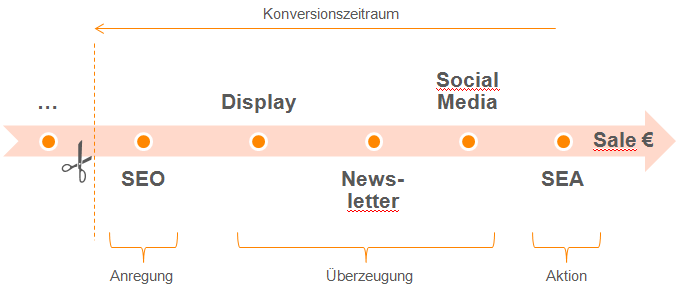The Customer Journey describes the process visitor takes up until the final decision and conversion. Contact with the means of advertising and website views are viewed as stations on the journey to the target. For spontaneous or very targeted purchases, the customer journey can consist of one individual contact. Customer journeys can however continue on over longer periods and through numerous stations.
If the customer journey consists of multiple contacts with different advertising means or channels, then the question arises as to what contribution the individual contacts made towards the success and thus how much of a share of the sale should go to which advertising medium. This can be done by so-called attribution or distribution models, which distribute the sale according to certain rules or weightings or weightings on contact points.
But the reason for doing this is also to better understand the user so as to be able to
- create campaigns in such a way that they result in a sensible interplay between the advertising media. So you need to know not only which measures should be viewed singularly, but also which combinations bring about the highest degree of success.
- It is also about designing advertising and landing pages in such a way that the visitors are addressed at the right time during their decision-making process. In this respect, the advertising media contacts are connected to a multi-level model of a purchase decision process. In many cases, the effectiveness of advertising media is not equally distributed across each phase, instead core areas result which take into account the customer journeys of all visitors.
The aim of the etracker customer journey report is to provide information on to how great an extent, in which combination and in which phases advertising measures contribute to the success.
Report “Advertising Effect”
The Advertising Effect report makes transparent the effect of channels (media), campaigns and keywords:
- primarily the stimulation of customer interest (that is, being at the start of chains with at least two contacts)
- put in effort to convince (that is, be in the middle of chains with three or more contacts)
- trigger the desired conversion at the end of a chain with at least two contacts
- be directly responsible for the desired conversion without further contracts (direct purchase)
From the four cases illustrated, there are four key figures in the report: stimulation, conviction, action and direct purchase. Example:


Report “Contact combinations”
The contact combinations report under Marketing Reports → Customer Journey shows the sequence of contacts of a visitor, grouped according to the number of contacts. The distribution of the contact count by orders or sales shows
- if there are interdependencies or if these need to be taken into account (if a significant share causes more than one contact, whereupon sequences of the same media are found again in the contact chains and type-ins are also applicable as contacts.
- how long or complex the decision-making process is (the greater the number of contacts, the more complex the process).
By activating the contact sequence, you can view the top sequences by amount (see 1). You can sort by orders, sales or frequency using the column labels (see 2). This way you can see which combinations are the most successful. Additionally, the report also supplies information on whether certain media appears more towards the start or to the end of the contact chains. You do not have to laboriously derive information from the individual contact chains in order to discover core effectiveness areas in the decision-making phases. Instead you can use the Advertising effect report.